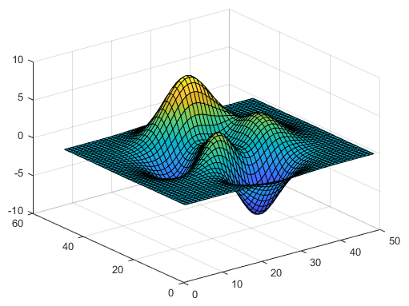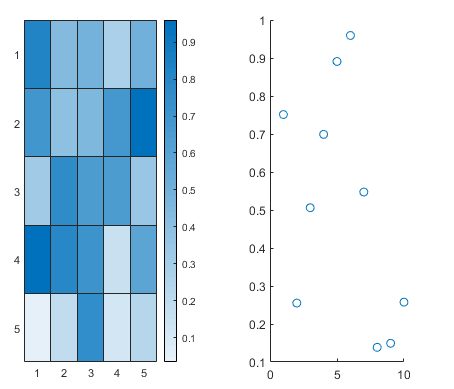rendererinfo
图形渲染器信息
说明
示例
获取当前会话的默认渲染器信息。
info = rendererinfo
info = struct with fields:
GraphicsRenderer: 'WebGL'
Vendor: 'Google Inc. (Google)'
Version: 'WebGL 2.0 (OpenGL ES 3.0 Chromium)'
RendererDevice: 'ANGLE (Google, Vulkan 1.2.0 (SwiftShader Device (Subzero) (0x0000C0DE)), SwiftShader driver)'
Details: [1×1 struct]
创建 peaks 函数的曲面图。
surf(peaks)

获取当前坐标区,然后获取坐标区的渲染器信息。您的系统可能会返回不同信息。
ax = gca; info = rendererinfo(ax)
info =
struct with fields:
GraphicsRenderer: 'WebGL'
Vendor: 'Google Inc. (NVIDIA)'
Version: 'WebGL 2.0 (OpenGL ES 3.0 Chromium)'
RendererDevice: 'ANGLE (NVIDIA, NVIDIA Quadro P600 (0x00001CB2) Direct3D11 vs_5_0 ps_5_0, D3D11)'
Details: [1×1 struct]
获取驱动详细信息。
info.Details
ans =
struct with fields:
HardwareSupportLevel: 'Full'
SupportsDepthPeelTransparency: 1
SupportsAlignVertexCenters: 1
SupportsGraphicsSmoothing: 1
MaxTextureSize: 16384
MaxFrameBufferSize: 16384在图窗中创建一个热图和一个散点图。
tiledlayout(1,2) nexttile h = heatmap(rand(5)); ax1 = nexttile; scatter(ax1,1:10,rand(1,10))

获取热图和散点图父坐标区的渲染器信息。在本例中,info 是包含两个结构体的数组。
info = rendererinfo([h ax1])
info =
1×2 struct array with fields:
GraphicsRenderer
Vendor
Version
RendererDevice
Details对数组进行索引以获取热图的渲染器版本。您的系统可能会返回不同的版本信息。
info(1).Version
ans =
'WebGL 2.0 (OpenGL ES 3.0 Chromium)'输入参数
输出参量
渲染器信息,返回为结构体,其中包含图形渲染器名称、供应商和版本等信息。Details 字段是嵌套结构体,包含其他详细信息。下表说明 info 结构体和 info.Details 结构体。
如果您将 target 指定为 n 个坐标区或独立可视化的数组,info 将返回为 1×n 结构体数组。数组中的每个结构体对应于 target 的一个元素。
Info 结构体
所有系统都会返回以下字段。
| 字段 | 描述 |
|---|---|
GraphicsRenderer | 图形渲染器,返回为下列值之一:
|
Vendor | 图形渲染器实现的制造商。 |
Version | 图形渲染器实现的版本。 |
RendererDevice | 支持图形渲染器的设备。如果您在使用硬件加速图形,则此字段是显卡型号名称。 |
Details | 嵌套结构体,其中包含其他详细信息,例如渲染器的驱动版本。对于 Painters 渲染器,此结构体为空。 |
Details 结构体
Details 结构体包含以下字段。
在 R2025a 之前的版本中: 有些系统会根据图形渲染器返回这些字段的子集。
| 字段 | 描述 |
|---|---|
HardwareSupportLevel | 硬件支持级别,以下列值之一形式返回:
|
SupportsDepthPeelTransparency | 深度剥离透明度功能支持,如果支持,则返回 |
SupportsAlignVertexCenters | 对齐顶点中心功能支持,如果支持,则返回 |
SupportsGraphicsSmoothing | 图形平滑处理功能支持,如果支持,则返回 |
MaxTextureSize | 渲染器支持的最大纹理大小(以像素为单位)。 |
MaxFrameBufferSize | 渲染器支持的最大帧缓冲区大小(以像素为单位)。 |
版本历史记录
在 R2019a 中推出所有支持运行 MATLAB 的系统也支持大多数常见的 MATLAB 图形功能,如图形平滑和对齐的顶点中心。
在 R2025a 之前的版本中: 有关这些功能以及您的系统是否支持它们的信息,请参阅高级图形功能。
嵌套的 Details 结构体不再包含 RendererDriverVersion 和 RendererDriverReleaseDate 字段。
不带任何参量调用 rendererinfo 函数来查询默认图形渲染器信息。此新语法允许您以与 opengl 语法一致的方式调用 rendererinfo 函数。
rendererinfo 可以提供特定坐标区或独立可视化的渲染器信息,并且可以报告有关 WebGL™ 渲染器的信息。opengl 函数不提供这些功能。
MATLAB Command
You clicked a link that corresponds to this MATLAB command:
Run the command by entering it in the MATLAB Command Window. Web browsers do not support MATLAB commands.
选择网站
选择网站以获取翻译的可用内容,以及查看当地活动和优惠。根据您的位置,我们建议您选择:。
您也可以从以下列表中选择网站:
如何获得最佳网站性能
选择中国网站(中文或英文)以获得最佳网站性能。其他 MathWorks 国家/地区网站并未针对您所在位置的访问进行优化。
美洲
- América Latina (Español)
- Canada (English)
- United States (English)
欧洲
- Belgium (English)
- Denmark (English)
- Deutschland (Deutsch)
- España (Español)
- Finland (English)
- France (Français)
- Ireland (English)
- Italia (Italiano)
- Luxembourg (English)
- Netherlands (English)
- Norway (English)
- Österreich (Deutsch)
- Portugal (English)
- Sweden (English)
- Switzerland
- United Kingdom (English)